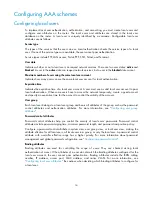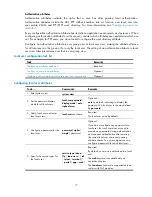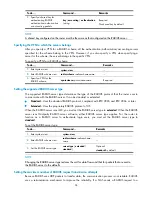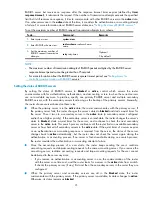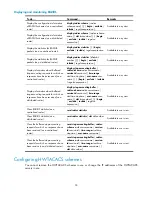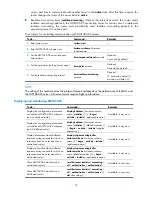
27
To do…
Command…
Remarks
3.
Set the format for usernames
sent to the RADIUS servers.
user-name-format
{
keep-original
|
with-domain
|
without-domain
}
Optional.
By default, the ISP domain name
is included in a username.
4.
Specify the unit for data flows
or packets sent to the RADIUS
servers.
data-flow-format
{
data
{
byte
|
giga-byte
|
kilo-byte
|
mega-byte
}
|
packet
{
giga-packet
|
kilo-
packet
|
mega-packet
|
one-
packet
} }*
Optional.
By default,
byte
for data flows
and
one-packet
for data packets.
NOTE:
•
If a RADIUS scheme defines that the username is sent without the ISP domain name, do not apply the
RADIUS scheme to more than one ISP domain. Otherwise, users using the same username but in
different ISP domains are considered to be the same user.
•
For level switching authentication,
user-name-format keep-original
and
user-name-format without-
domain
produce the same results: they ensure that usernames sent to the RADIUS server carry no ISP
domain name.
Specifying the source IP address for outgoing RADIUS packets
The source IP address of RADIUS packets that a NAS sends must match the IP address of the NAS
configured on the RADIUS server. A RADIUS server identifies a NAS by its IP address. Upon receiving a
RADIUS packet, a RADIUS server checks whether the source IP address of the packet is the IP address of
any managed NAS. If it is, the server processes the packet. If it is not, the server drops the packet.
Usually, the source address of outgoing RADIUS packets can be the IP address of the any interface of
the NAS that can communicate with the RADIUS server. In some special scenarios, however, you must
change the source IP address. For example, if a NAT device is present between the NAS and the
RADIUS server, the source IP address of outgoing RADIUS packets must be a public IP address of the
NAS. If the NAS is configured with the VRRP for stateful failover, the source IP address of outgoing
RADIUS packets can be the virtual IP address of the uplink's VRRP group.
Specify a source IP address for outgoing RADIUS packets in RADIUS scheme view for a specific RADIUS
scheme, or in system view for all RADIUS schemes whose servers are in a VPN or the public network.
Before sending a RADIUS packet, a NAS selects a source IP address in this order:
1.
The source IP address specified for the RADIUS scheme.
2.
The source IP address specified in system view for the VPN or public network, depending on where
the RADIUS server resides.
3.
The IP address of the outbound interface specified by the route.
To specify a source IP address for all RADIUS schemes in a VPN or the public network:
To do…
Command…
Remarks
1.
Enter system view.
system-view
—
2.
Specify a source IP
address for outgoing
RADIUS packets.
radius nas-ip
{
ip-address
|
ipv6
ipv6-address
} [
vpn-
instance
vpn-instance-name
]
Required.
By default, the IP address of the outbound
interface is used as the source IP address.




